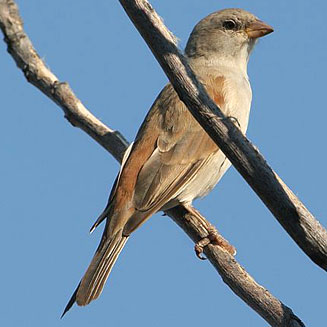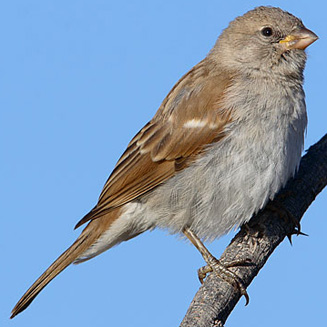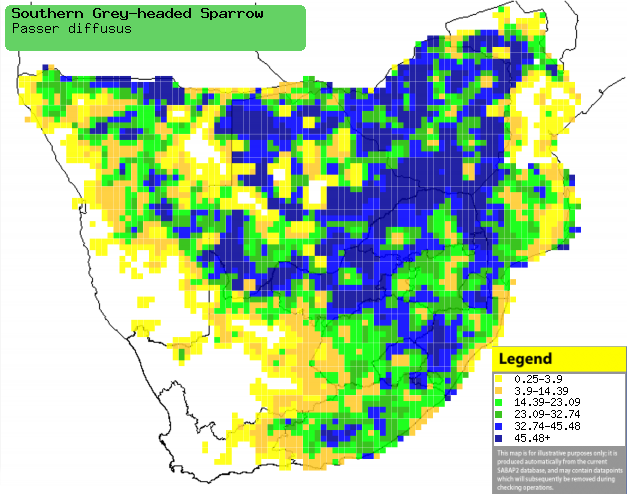|
Passer diffusus (Southern
grey-headed sparrow)
Gryskopmossie [Afrikaans]; Enzunge (applied to some of the
bishops, widows and sparrows) [Kwangali]; Serobele (generic term for sparrows)
[South Sotho]; Tswere (generic term for sparrows, petronias and canaries
[Tswana]; Mozambique-mus [Dutch]; Moineau sud-africain [French];
Graukopfsperling [German]; Pardal-de-cabeça-cinzenta-meridional [Portuguese]
Life
> Eukaryotes >
Opisthokonta
> Metazoa (animals) >
Bilateria >
Deuterostomia > Chordata >
Craniata > Vertebrata (vertebrates) > Gnathostomata (jawed
vertebrates) > Teleostomi (teleost fish) > Osteichthyes (bony fish) > Class:
Sarcopterygii (lobe-finned
fish) > Stegocephalia (terrestrial
vertebrates) > Tetrapoda
(four-legged vertebrates) > Reptiliomorpha > Amniota >
Reptilia (reptiles) >
Romeriida > Diapsida > Archosauromorpha > Archosauria >
Dinosauria
(dinosaurs) > Saurischia > Theropoda (bipedal predatory dinosaurs) >
Coelurosauria > Maniraptora > Aves
(birds) >
Order: Passeriformes > Family: Passeridae
 |
 |
|
Southern grey-headed sparrow, Tswalu Kalahari
Reserve, South Africa. [photo Trevor Hardaker ©] |
Southern grey-headed sparrow, Kgalagadi National
Park, South Africa. [photo Johann Grobbelaar
©] |
Distribution and habitat
Occurs from western and southern Angola through Zambia to
southern Africa, where it is fairly common to common across much of the region,
excluding the arid west of Namibia and South Africa. It generally prefers
savanna woodland, especially with Acacia, also occupying dry broad-leaved
woodland, plantation edges, cultivated land and gardens.
|
 |
|
Distribution of Southern grey-headed sparrow in
southern Africa, based on statistical smoothing of the records from
first SA Bird Atlas Project (©
Animal Demography unit, University of
Cape Town; smoothing by Birgit Erni and Francesca Little). Colours range
from dark blue (most common) through to yellow (least common).
See here for the latest distribution
from the SABAP2. |
Predators and parasites
It has been recorded as prey of
Tyto alba
(Barn owl); additionally nestlings are sometimes parasitised by
Passeromyia heterochaeta (Tropical nest fly).
Brood parasites
It has been recorded as host of the
Diderick
cuckoo.
Food
It eats seeds, fruit, nectar and insects, doing most of its
foraging on the ground, often in flocks with other granivorous birds. The following food items have been recorded
in its diet:
- Plants
- seeds
- grasses
- forbs
- Boerhavia repens (Spiderling)
- Alternanthera (paperthorns)
- fruit
- Lycium (honey-thorns)
- Ficus bussei (Zambezi fig)
- nectar
- Aloe marlothii (Mountain aloe)
- Aloe greatheadii (Spotted aloe)
- Insects
Breeding
- It is a monogamous, usually solitary nester, although it occasionally
breeds in loose colonies.
- The nest (see image below) is built by both sexes, consisting of a
simple pad of grass, leaf petioles, weed stems, hair and feathers. It is
typically placed in a tree cavity, either natural or an abandoned nest of a
woodpecker or
barbet, or in a hole in a wall, hollow
fence post, nest box, under the eaves of a building, in a chimney or an old
nest of another bird such as a Little
swift, swallow or a chamber of a
Red-billed buffalo-weaver
colony.
- Egg-laying season is from September-June, peaking from about
December-April.
- It lays 2-6 eggs, which are incubated by both sexes for about 11-14
days.
- The chicks are brooded and fed by both adults on a diet of insects,
leaving the nest after about 16-19 days. The fledglings remain dependent on
their parents for about 14-21 days more, but they still roost in the nest
for a further 13-20 days.
Threats
Not threatened, in fact it has adapted to the modification
of habitats by humans, causing its range to expand.
References
-
Hockey PAR, Dean WRJ and Ryan PG 2005. Roberts
- Birds of southern Africa, VIIth ed. The Trustees of the John Voelcker
Bird Book Fund, Cape Town.
|
